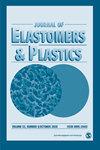Dependence of Adhesion Property of SMR L-based Adhesives on Antioxidants
IF 1.6
4区 材料科学
Q4 MATERIALS SCIENCE, MULTIDISCIPLINARY
引用次数: 2
Abstract
The viscosity, tack, peel, and shear strength of Standard Malaysian Rubber (SMR L grade)-based pressure-sensitive adhesives was studied in the presence of two types of antioxidants, that is, 2,6-di-tert-butyl-p-cresol (BHT) and 2,2,4-trimethyl-1,2-dihydroquinoline (TMQ) using coumarone-indene resin and toluene as the tackifier and solvent, respectively. The concentration of antioxidant was varied from 1 to 4 parts per hundred parts of rubber (phr). A SHEEN hand coater was used to coat the adhesive on polyethylene terephthalate substrate to give a coating thickness of 90 μm. Viscosity was determined by a HAAKE Rotary Viscometer. Tack, peel, and shear strength were measured using a Lloyd Adhesion Tester operating at 30 cm/min. Results indicate that the viscosity and shear strength decreases with increasing antioxidant concentration, an observation that is attributed to the plasticizing effect of the antioxidants. However, tack and peel strength shows the reverse behavior, a phenomenon that is associated to the increasing wettability and compatibility of adhesive on the substrate as antioxidant concentration is increased. Except for the shear strength, BHT antioxidant consistently exhibits a higher viscosity, tack, and peel strength compared to TMQ antioxidant.抗氧化剂对SMR - l基胶粘剂粘接性能的影响
以香豆素树脂为增粘剂,以甲苯为溶剂,在2,6-二叔丁基对甲酚(BHT)和2,2,4-三甲基-1,2-二氢喹啉(TMQ)两种抗氧剂的存在下,研究了马来西亚标准橡胶(SMR L级)基压敏胶的粘度、粘性、剥离和剪切强度。抗氧化剂的浓度为1 ~ 4 /百份橡胶(phr)。采用SHEEN手涂布机将胶粘剂涂在聚对苯二甲酸乙二醇酯基材上,涂层厚度为90 μm。粘度由HAAKE旋转粘度计测定。粘连强度、剥离强度和抗剪强度采用劳氏粘连测试仪以30厘米/分钟的速度进行测量。结果表明,随着抗氧剂浓度的增加,抗氧剂的黏度和抗剪强度降低,这与抗氧剂的塑化作用有关。然而,粘性和剥离强度表现出相反的行为,这一现象与随着抗氧化剂浓度的增加,粘合剂在基材上的润湿性和相容性增加有关。除了抗剪强度外,BHT抗氧化剂与TMQ抗氧化剂相比,始终具有更高的粘度、粘性和剥离强度。
本文章由计算机程序翻译,如有差异,请以英文原文为准。
求助全文
约1分钟内获得全文
求助全文
来源期刊

Journal of Elastomers and Plastics
工程技术-材料科学:综合
CiteScore
3.30
自引率
5.90%
发文量
41
审稿时长
6 months
期刊介绍:
The Journal of Elastomers and Plastics is a high quality peer-reviewed journal which publishes original research on the development and marketing of elastomers and plastics and the area in between where the characteristics of both extremes are apparent. The journal covers: advances in chemistry, processing, properties and applications; new information on thermoplastic elastomers, reinforced elastomers, natural rubbers, blends and alloys, and fillers and additives.
 求助内容:
求助内容: 应助结果提醒方式:
应助结果提醒方式:


